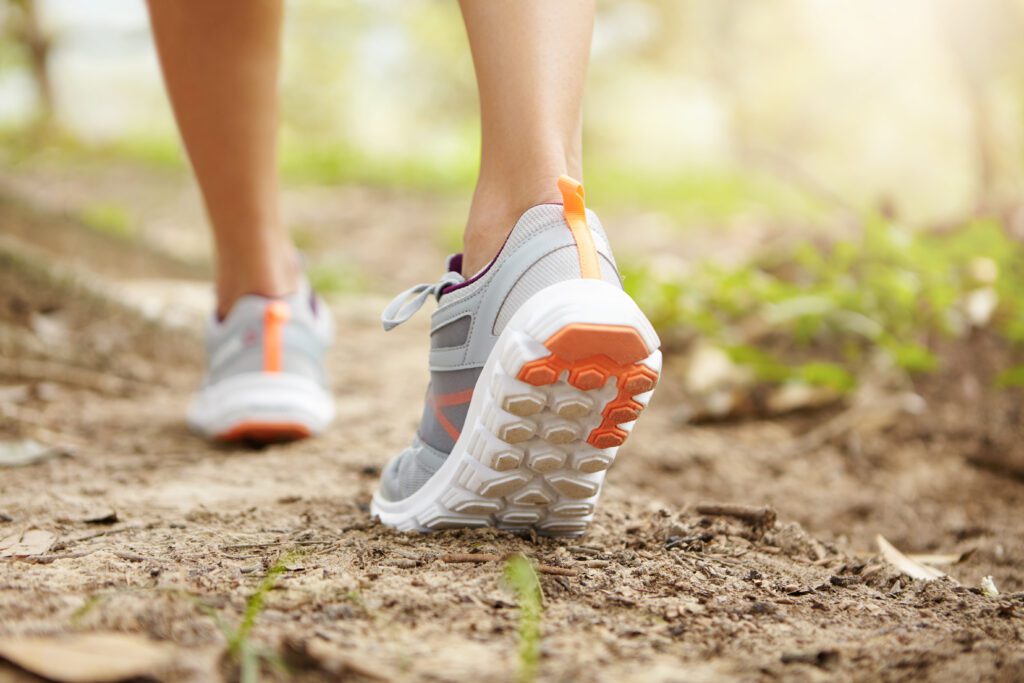Happy National Walking Day!
The first Wednesday in April is National Walking Day and it encourages Americans of all ages to get out and stretch their legs and get their hearts pumping. Science has shown us that being outdoors and in nature may boost immunity while lowering stress levels and improving mood. So, wear your sneakers (or take them with you) to work, and at some point in the day, take a 30-minute walk.
The History of National Walking Day
Walking has always been a part of being human. Many archaeologists have found that even when humans were nomadic tribes, we would often walk great distances to stalk our prey (think Wooly Mammoths) and wait for them to sleep before pouncing. Walking is, essentially, what humans are physically best at. We’re the slowest runners, the worst swimmers, and we can’t even fly without a big jet engine. Walking is the humans’ bread and butter.
Maybe that’s why during the Victorian era there was a little fad called pedestrianism, where walking became one of the major spectator sports in America and Europe until baseball usurped it. But individuals would wager massive bets over whether walkers could make it marathon distances and under what time. There’s a reason why racewalking is an Olympic sport, after all.
Whether it’s John Muir’s spiritual journeys through the woods; pilgrimages to Mecca; or just a casual stroll through your local park, walking has always held a close, dear place in the hearts of humans. It’s no wonder that there are so many health benefits associated with it and also why National Walking Day was created to promote this fantastic and surprisingly easy pastime.
The American Heart Association sponsors this day to remind people about the health benefits of taking a walk. The best part – these benefits apply to people of all ages and fitness levels. It may also help prevent certain diseases and even prolong your life.
12 Major Benefits of Walking:
1. Lose weight:
Walking can help you burn calories. Burning calories can help you maintain or lose weight. A brisk 30-minute walk burns 200 calories. Over time, calories burned can lead to pounds dropped.
2. Strengthen the heart:
Walking wards off heart disease brings up the heart rate, lowers blood pressure, and strengthens the heart. Post-menopausal women who walk just one to two miles a day can lower their blood pressure by nearly 11 points in 24 weeks. Women who walk 30 minutes a day can reduce their risk of stroke by 20%, and by 40% when they stepped up the pace, according to researchers at the Harvard School of Public Health in Boston.Walking at least 30 minutes a day, five days a week can reduce your risk for coronary heart disease by about 19 percent. And your risk may reduce even more when you increase the duration or distance you walk per day.
3. Can help lower your blood sugar:
Taking a short walk after eating may help lower your blood sugar. A small study found that taking a 15-minute walk three times a day (after breakfast, lunch, and dinner) improved blood sugar levels more than taking a 45-minute walk at another point during the day.More research is needed to confirm these findings, though. Consider making a post-meal walk a regular part of your routine. It can also help you fit in exercise throughout the day.
4. Eases joint pain and strengthens bones:
Walking can help protect the joints, including your knees and hips. That’s because it helps lubricate and strengthen the muscles that support the joints. It also provides benefits for people living with arthritis, such as reducing pain. Walking 5 to 6 miles a week may also help prevent arthritis.Walking can stop the loss of bone mass for those with osteoporosis. One study of postmenopausal women found that 30 minutes of walking each day reduced their risk of hip fractures by 40%.
5. Boosts immune function:
Walking may reduce your risk of developing a cold or the flu. One study tracked 1,000 adults during flu season. Those who walked at a moderate pace for 30 to 45 minutes a day had 43 percent fewer sick days and fewer upper respiratory tract infections overall. Their symptoms were also lessened if they did get sick. That was compared to adults in the study who were sedentary.Try to get in a daily walk to experience these benefits. If you live in a cold climate, you can try to walk on a treadmill or around an indoor mall.
6. Boost your energy:
Going for a walk when you’re tired may be a more effective energy boost than grabbing a cup of coffee. Walking increases oxygen flow through the body. It can also increase levels of cortisol, epinephrine, and norepinephrine. Those are the hormones that help elevate energy levels.
7. Improve your mood:
Walking can help your mental health. Studies show it can help reduce anxiety, depression, and a negative mood. It can also boost self-esteem and reduce symptoms of social withdrawal.To experience these benefits, aim for 30 minutes of brisk walking or other moderate-intensity exercises three days a week. You can also break it up into three 10-minute walks.
8. Slow Down Mental Decline:
A study of 6,000 women, ages 65 and older, performed by researchers at the University of California, San Francisco, found that age-related memory decline was lower in those who walked more. The women walking 2.5 miles per day had a 17% decline in memory, as opposed to a 25% decline in women who walked less than a half-mile per week.A study from the University of Virginia Health System in Charlottesville found that men between the ages of 71 and 93 who walked more than a quarter of a mile per day had half the incidence of dementia and Alzheimer’s disease than those who walked less.
9. Extend your life:
Walking at a faster pace could extend your life. Researchers found that walking at an average pace compared to a slow pace resulted in a 20 percent reduced risk of overall death.Walking at a brisk or fast pace (at least 4 miles per hour) reduced the risk by 24 percent. The study looked at the association of walking at a faster pace with factors like overall causes of death, cardiovascular disease, and death from cancer.Research finds that people who exercise regularly in their fifties and sixties are 35% less likely to die over the next eight years than their non-walking counterparts. That number shoots up to 45% less likely for those who have underlying health conditions.
10. Improve Sleep:
Studies found that women, ages 50 to 75, who took one-hour morning walks, were more likely to relieve insomnia than women who didn’t walk.
11. Tone your legs:
Walking tones your leg and abdominal muscles – and even arm muscles if you pump them as you walk. This increases your range of motion, shifting the pressure and weight from your joints to your muscles.To build up more strength, walk in a hilly area or on a treadmill with an incline. Or find routes with stairs. Also, trade-off walking with other cross-training activities like cycling or jogging. You can also perform resistance exercises like squats, lunges, and leg curls to further tone and strengthen your leg muscles.
12. Creative thinking:
Walking may help clear your head and help you think creatively. A study that included four experiments compared people trying to think of new ideas while they were walking or sitting. Researchers found participants did better while walking, particularly while walking outdoors.The researchers concluded that walking opens up a free flow of ideas and is a simple way to increase creativity and get physical activity at the same time. Try to initiate a walking meeting with your colleagues the next time you’re stuck on a problem at work.
National Walking Day Statistics:
48% don’t get enough exercise
Less than 48% of adults in the US get enough aerobic exercise to improve their health. That includes walking! Get outside and get that heart rate up!
15 minutes to curb cravings
All it takes is 15 minutes of walking to actually curb a craving for chocolate or other sweet-related foods. Next time you’re looking for something sweet, take a walk around the block.
20 minutes for fewer sick days
A study found that those who walked twenty minutes per day for five days a week reported taking nearly fifty percent fewer sick days than those who exercised once per week or less!
Here are some great ways to make that 30-minutes more enjoyable:
- Wear comfortable clothes.
- Take a friend to pass the time.
- Make sure to stretch those muscles.
- Drink plenty of water.
- Move your arms, too.
- Make sure you have good posture.
HOW TO OBSERVE #NationalWalkingDay
Take thirty minutes out of your day to go for a walk. There are many beautiful state parks and natural spaces around us. Find a trail near you to explore or walk around your neighborhood. You can also visit a local park or walk on your treadmill. Take your canine pals with you- they need the cardiovascular workout, too! When the family has finished their walk around the block or park, complete this fun word search puzzle. Happy walking!

